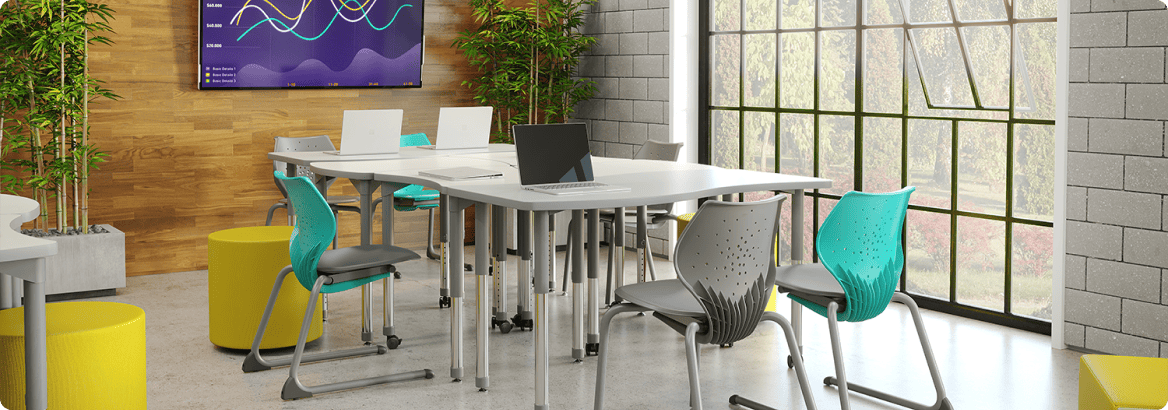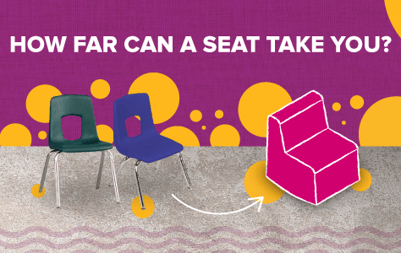
Questions about Flexible Seating
Wondering how flexible seating can elevate your classroom? Backed by research and designed for today’s learners, flexible seating increases engagement and supports every learning style. Explore our FAQs for expert insights and practical tips to help you create a dynamic, student-centered environment.

Artcobell
our goal is to build chairs that support students.
Because we want them to focus on what's in front of them instead of what's under them.
About Flexible Seating
More Choices. Better Learning.
-
What is Flexible Seating?
Flexible seating is a forward-thinking approach to classroom design that moves beyond traditional desks, offering students a choice of seating options—like couches, bean bag chairs, stools, floor mats, and standing desks. Based on insights from Artcobell’s research, this model empowers students to select the spot where they learn best, encouraging comfort, choice, and greater engagement in every learning environment.
-
Why is Flexible Seating Important in the Classroom?
Flexible seating is important because it boosts student engagement and creates a student-centered, modern learning environment. Research shows that a flexible arrangement can make the classroom more inviting and interactive, increasing students’ interest and collaboration with peers. By reducing boredom and allowing movement, flexible classroom seating helps students stay focused and comfortable, which can lead to better participation and learning outcomes.
-
What Types of Flexible Seating are There?
Modern classrooms offer many flexible seating options, such as couches, bean bag chairs, floor cushions, mats, wobble stools, exercise balls, standing desks, and portable lap desks. With choices ranging from low lounge chairs to tall stools, students can pick the seat that works best for them.
-
Who Benefits from Flexible Seating?
Flexible seating supports every student by honoring their unique learning needs and energy levels. Active learners can move and stretch, boosting focus and engagement, while others can find a relaxing spot to concentrate. By giving students the freedom to choose, flexible seating fosters a more inclusive classroom—empowering each learner to thrive.
-
When Should I Use Flexible Seating in the Classroom?
Flexible seating can be used throughout the day whenever it supports your lesson plan. It’s ideal for activities that encourage movement or teamwork—think quiet reading on floor cushions, independent work in a cozy corner, or group projects around high-top tables and standing desks. The best results come from introducing flexible options thoughtfully, using them when they truly enhance learning while minimizing distractions.
-
What Classroom Furniture Works Best for Flexible Seating?
The most effective furniture for flexible seating is adaptable, comfortable, and easy to move. Many teachers begin with cushions, mats, or stools that encourage choice. Mobile tables, lightweight chairs, and modular desks make it simple to reconfigure spaces to match any activity. Durable soft seating—like ottomans or bean bags—and adjustable-height desks empower students to learn in ways that work best for them, supporting today’s dynamic classrooms.
-
How Do I Help Students Pick out the Right Flexible Seating?
Empower students to find the best flexible seating by involving them in the process and setting clear expectations. Encourage them to try different options and notice where they feel most focused and comfortable. Invite student input on seating choices, and guide them to reflect on what helps them learn best. With a bit of encouragement and thoughtful direction, you help each learner make confident choices that support their success.
-
How Does Flexible Seating Help Students Learn?
Flexible seating supports student success by addressing both physical comfort and learning styles. When students can move — using options like standing desks or wobble stools—they experience better focus and energy. By choosing seats that fit how they learn best, whether visual, auditory, or kinesthetic, students are empowered to understand and engage more fully. This adaptive classroom environment encourages collaboration, sparks creativity, and builds critical thinking — key skills for thriving in today’s world.
-
How Do I Implement Flexible Seating in the Classroom?
Successful flexible seating starts with thoughtful planning and clear communication. Set a purpose for introducing flexible seating and share it with students and families. Start small by adding a few new seating options to your classroom, and establish clear guidelines for how to use each space. Teach students to move, share, and care for furniture respectfully. Engage them in arranging the classroom and gathering feedback so you can adjust the setup and ensure every student has the support they need to succeed.
-
Where Can I Buy Flexible Seating?
You can buy flexible seating through various school furniture suppliers and retailers. Artcobell and other education furniture companies offer a range of flexible seating options – from modular desks and tables to soft seating and mobile chairs. Many teacher supply stores and online marketplaces also carry flexible classroom seating products. When shopping, look for durable, student-friendly furniture that supports modern learning environments and student engagement